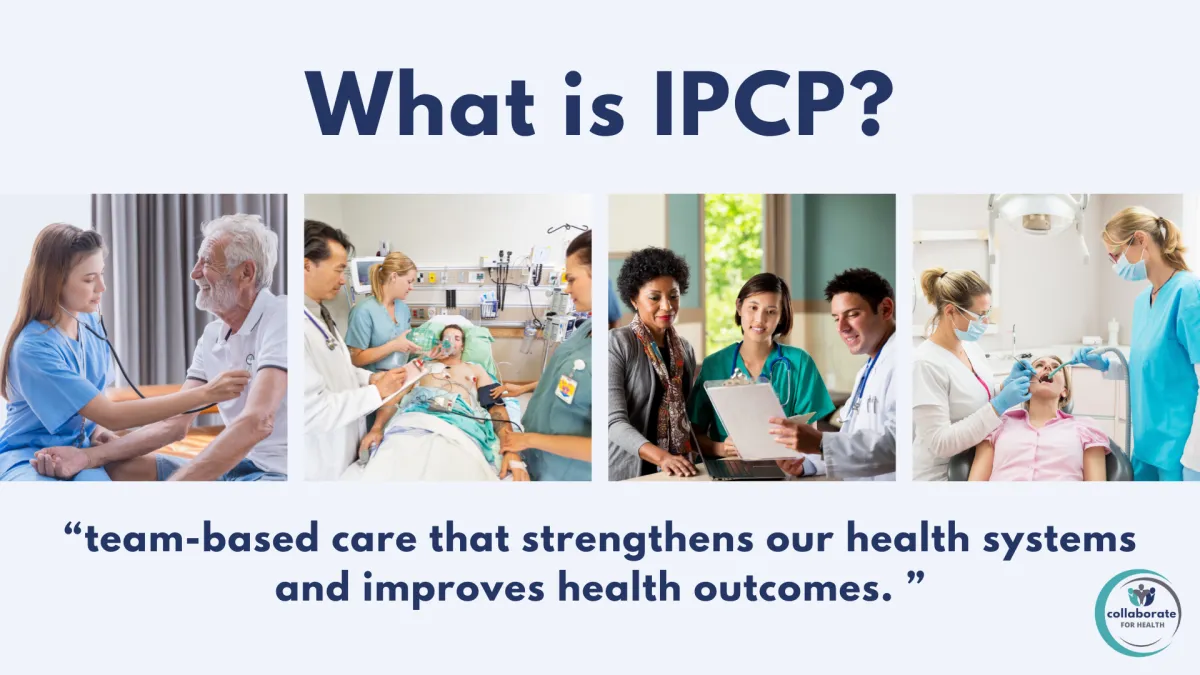BLOG
Welcome to Collaborate for Health, where we champion the power of collaboration to transform healthcare. Explore our collection of insightful articles and blogs, crafted to illuminate the benefits of teamwork in healthcare. From enhancing patient outcomes to streamlining administrative processes, our content is rich with valuable insights. Dive into a wealth of knowledge designed to inspire and inform. Take a moment to explore our website and unlock the potential of collaboration for a healthier future. Read the latest articles covering a variety of topics and perspectives on interprofessional education, interprofessional collaboration, patient advocacy, teamwork and collaboration skills. We are BETTER TOGETHER!
ADVANCING INTERPROFESSIONAL COLLABORATIVE PRACTICE
Want to contribute? Have questions or comments about article topics or content?
Please contact us via email.

What is Interprofessional Collaboration
Interprofessional Collaboration (IPC) or Interprofessional Collaborative Practice (IPCP) is a type of team-based care that strengthens our health systems and improves health outcomes. By working together across professions, we can tackle complex health conditions more effectively and efficiently.

"Collaborative practice happens when multiple health workers from different professional backgrounds work together with patients, families, carers and communities to deliver the highest quality of care. It allows health workers to engage any individual whose skills can help achieve local health goals." (World Health Organization, 2010)
Interprofessional education (IPE) is a prerequisite for IPCP. New healthcare graduates have likely had exposure to IPE training. In the United States, there are over 20 health program accreditation organizations that require IPE during formal training. IPE prepares learners to practice collaboratively by increasing their knowledge about other professional roles and training and by decreasing negative professional stereotypes.
In the United States, the Interprofessional Education Collaborative (IPEC) developed a competency framework to guide IPE and IPCP. The framework includes one overarching domain (interprofessional collaboration), four competencies (values and ethics, roles & responsibilities, communication, and teams & teamwork), and 33 related sub-competencies. The IPEC competencies provide a uniform language

In the United States and increasingly throughout the world, the IPEC competencies have emerged as one of the most valuable and widely utilized educational resources to prepare learners for interprofessional teamwork. (IPEC, 2023).
What is Interprofessional Collaboration (IPC)?
To truly grasp the essence of IPCP, it's crucial to understand what it is not. Let's use the action of engaging in huddles or rounds as an opportunity to debunk a few misconceptions:
1. IPCP is not having a morning huddle or conducting discharge rounds. Simply having a team of various health professionals gather to discuss a patient or client does not automatically qualify it as IPCP. Remember the patient or client must be present. In the event the patient cannot be present, a caregiver or patient advocate can represent the patient and their wishes. IPCP inherently includes the patient as the leader of their health team.
Patient-centered or client-centered care is at the heart of IPCP. Typically, patient-centered care is depicted with the patient at the center, surrounded by their health team. However, this image doesn’t fully capture the patient's role as an active team member. Instead, imagine the patient stepping out of the center and joining the team in a circle, becoming a true partner in their care.

2. IPCP is not focused on the same health professional leading a huddle or rounds. We often hear about physician or nurse-led teams. In IPCP, there is only 1 leader of the team and that is the patient or the client. However, in order to provide a consistent structure and increase efficiency, typically, the health professional leading huddle or rounds discussions is a physician or a case manager. However, IPCP promotes shared leadership. Shared leadership is not simply about taking turns, it is about taking individual accountability for the role of a leader and being prepared to facilitate a discussion about the patient's goals, needs and resources. In order to prepare your team for shared leadership, training will be required.

IPCP goes beyond a checklist of tasks. When optimized, IPCP is transformative and can decrease health professional burnout, enhance healthcare delivery and improve patient outcomes. As you continue to learn, engage and promote interprofessional work, please remember to avoid the hyphen.

To continue to learn more about interprofessional education and inteprofessional collaboration, visit me on Linkedin or browse my website collaborateforhealth.com.
ADVANCING INTERPROFESSIONAL
COLLABORATIVE PRACTICE
Want to contribute to sharing information? Have questions or comments about article topics or content?
Please contact us via email.

Transforming Healthcare Teams:
Building a Collaborative-Practice Ready Workforce
written by Tina Patel Gunaldo, PhD, DPT, MHS
In the ever-evolving landscape of healthcare, the traditional solo approach to education is fading away, making room for a more dynamic and collaborative future. Many health professional programs, a total of twenty-five, now mandate the integration of Interprofessional Education (IPE) into coursework, signaling a shift towards a workforce that is not only skilled in their respective fields but also adept at collaborative practice.
The World Health Organization (WHO) outlines three fundamental principles associated with IPE that serve as the foundation for preparing a "collaborative practice-ready" health workforce. This entails students from various professions learning not just from their coursework but from each other, fostering effective collaboration to enhance health outcomes. This approach becomes a crucial step in responding to local health needs and producing health workers competent and ready for interprofessional teamwork.
While integrating IPE into an already demanding curriculum presents challenges, the promise of collaborative practice cannot be overstated. The benefits extend beyond improved health outcomes to positively impact health professional job satisfaction, reduce burnout, enhance the patient experience, lower long-term health costs, and contribute to achieving the Quintuple Aim.
The healthcare industry has recognized the importance of teamwork in improving both individual health outcomes and population health measures. The National Academy of Sciences, back in 2003, urged the educational system to prepare health professionals for collaborative work, a call that gained further momentum with the support of the Centers for Medicare and Medicaid Services for collaborative models such as Accountable Care Organizations and Community Health Centers/Federally Qualified Health Centers. In 2011, the Interprofessional Education Collaborative Panel was established, providing guidance on behavioral expectations associated with interprofessional collaborative practice.
The realization that IPE is a lifelong learning topic, akin to ethics, cultural competence, and clinical skills, underscores the need for clinical and community-practice environments to offer ongoing IPE opportunities for providers. Countries like the United Kingdom, Australia, and Canada lead by example, demonstrating their commitment to interprofessional collaborative practices by employing personnel within clinical environments specialized in this area of practice. Embrace the transformative power of collaborative practice and explore how it can revolutionize the way healthcare teams function and deliver care for a brighter, healthier future.

2023-2024 Collaborate for Health. All Rights Reserved
